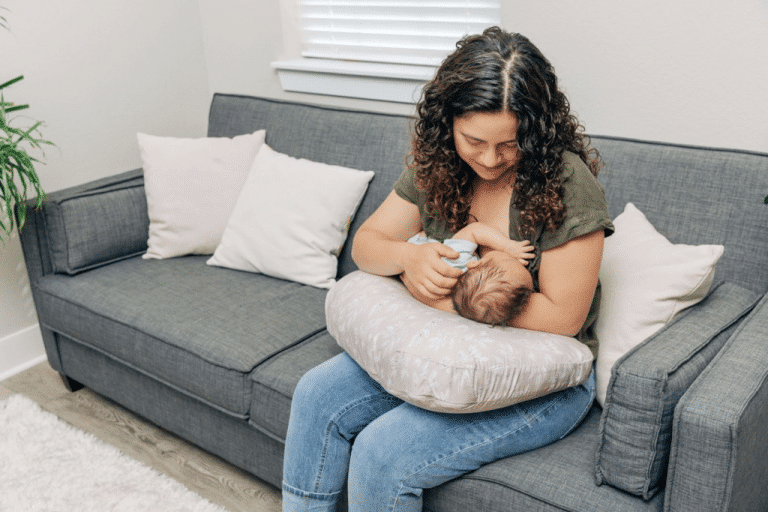Parents worldwide share this frustrating moment: the baby falls asleep, you put them down, and within 5 minutes, they’re wide awake and crying.
This common sleep pattern makes bedtime feel impossible and leaves parents tired and stressed.
Good news – there are simple ways to help babies stay asleep after being put down.
With the right methods and a bit of patience, parents can create better sleep habits that work for both baby and family.
This Blog offers tested tips to stop the “5-minute wake-ups,” explains why babies wake so quickly, and shares practical steps to make bedtime smoother.
We’ll look at room setup, timing tricks, and gentle methods that help babies sleep longer.
Why Does This Happen? Understanding the Causes
No parent likes those sudden wake-ups.
Let’s look at what causes them and how you can help your little one sleep better.
Reason 1: Too Tired to Sleep Properly
When babies become overly tired, their bodies produce stress hormones that make it harder for them to settle and rest.
Staying awake for too long often results in light and disrupted sleep.
Missing the optimal sleep window can lead to fussy behavior and frequent wake-ups.
Sleep-deprived babies are also more prone to startling, even from minor noises, further disrupting their ability to sleep peacefully and consistently.
Reason 2: Wrong Sleep Time and Setting
- Room temperature changes can wake babies – they sleep best in spaces between 68-72°F
- Bright lights or sudden darkness can disturb sleep patterns
- Loud or sudden noises often trigger the startle reflex in babies
- Background sounds that stop suddenly can wake babies up
- A room that’s too quiet might make some babies feel unsettled
Reason 3: Physical Comfort Issues
Wet or dirty diapers often cause quick wake-ups. Hungry babies typically don’t stay asleep for long.
Some babies wake if their clothing is too tight or scratchy
Gas or digestive discomfort frequently disrupts sleep. Body temperature changes as they fall into deeper sleep, which can cause stirring
Position changes when being put down might also wake them up.
Reason 4: Sleep Association Dependencies
- Babies often wake when they notice they’re no longer being held
- Some infants need specific conditions to stay asleep, like rocking or patting
- Moving a sleeping baby from arms to crib can trigger wake-ups
- Many babies haven’t learned to fall asleep on their own yet
Understanding the Difference Between Daytime and Nighttime Sleep Patterns
| Aspect | Daytime Sleep | Nighttime Sleep |
|---|---|---|
| Duration | Shorter naps (30 minutes to 2 hours) | Longer stretches (4-12 hours, depending on age) |
| Frequency | Multiple naps throughout the day | One continuous sleep period with possible wake-ups |
| Light Exposure | Bright and natural light exposure | Dark, calm environment |
| Stimulation | Higher activity and interaction levels | Minimal stimulation to encourage rest |
| Feeding Needs | More frequent feedings between naps | Fewer feedings, with possible stretches of sleep |
| Sleep Cycle Length | Shorter cycles, waking more easily | Longer sleep cycles, especially as the baby matures |
| Parental Interaction | Often requires active soothing to fall asleep | Less interaction during wake-ups to encourage self-soothing |
| Developmental Role | Supports short bursts of energy and brain activity | Promotes deeper restorative growth and memory |
How to Help Your Baby Sleep Longer After Being Put Down
Every baby can learn to sleep better. Here’s how parents can help create better sleep habits with some practical changes.
Setting Up the Right Sleep Space
- Keep the room comfortably warm – not too hot or cold
- Use a white noise machine to mask sudden sounds
- Install blackout curtains to control light levels
- Try a dim night light to create a calming space
- Make sure the crib mattress is comfortable and safe
Getting the Timing Right
- Watch for early sleep signs like eye rubbing or fussiness
- Put baby down at the first hint of tiredness
- Create a regular bedtime between 6:30-7:30 PM
- Plan naps based on the baby’s natural sleep windows
The Put-Down Method
- Wait until baby is drowsy but not fully asleep
- Lower them slowly into the crib
- Keep one hand on their chest for a minute
- Slowly remove your touch
- Stay nearby for a few minutes as they settle
If Baby Wakes Up
- Keep the room dark and quiet
- Pat their back gently
- Make calming “shh” sounds
- Don’t pick them up right away unless needed
- Give them a chance to resettle on their own
Sound Management Strategies
- Play the same calming music each night
- Keep consistent background noise levels
- Use a fan for steady white noise
- Block out sudden outdoor sounds
Movement Transitions
- Use a warm crib sheet to reduce temperature change
- Practice the “pause” method before intervening
- Try the “heel first, head last” put-down technique
- Keep your touch steady when moving the baby
- Give extra support to the head and neck during the transfer
Clear Signs That Your Baby Needs Sleep
Every parent wants to catch the perfect moment to put their baby down.
Here’s how to spot when your little one is ready for rest.
- Your baby rubs their eyes or ears – this is often the first sign of sleepiness.
- They stare blankly into space or seem less interested in toys and people
- You notice slower movements and less activity than usual
- The baby gets fussy and cries at small things that normally wouldn’t bother them
- They start to yawn repeatedly within a short time
- Your little one becomes clingier and wants to be held more
- The baby’s eyes look heavy, and they might have a slight redness around them
- You see them pulling at their ears or hair or repeatedly touching their face
Catching these signs early helps prevent overtiredness and makes bedtime smoother for everyone. When you spot several of these signals, it’s time to start your sleep routine.
How to Establish a Consistent Bedtime Routine
A good sleep routine helps babies know when it’s time to rest. It can turn difficult bedtimes into peaceful moments.
Parents often find that routines help their babies fall asleep faster and stay asleep longer.
Here’s how to build one that works.
1. The Perfect Timing:
The routine should start about 30 minutes before bedtime.
This gives babies time to wind down, but it isn’t so long that they get overtired. Pick a time that works with your family’s schedule and stick to it.
Most babies do well with bedtime between 6:30 and 7:30 PM.
The routine needs to happen at the same time each night – this helps set your baby’s internal clock.
2. Basic Steps to Follow:
Start with a warm bath – it helps lower body temperature, which makes babies feel sleepy.
After the bath, move to a quiet room with dim lights.
Use this time for gentle activities like putting on pajamas and reading a short book. Keep your voice soft and movements slow.
This helps signal to your baby that it’s time to calm down.
3. Feeding and Final Steps:
If you include feeding in your routine, do it in a quiet, dark place.
Keep the feeding calm and without distractions. After feeding, gently burp your baby and give them a few minutes of quiet cuddle time.
Place them in their crib while they’re drowsy but still awake. This helps them learn to fall asleep on their own.
4. Making Adjustments:
Watch how your baby responds to the routine. Some babies need more or less time for certain parts.
If something isn’t working, it’s fine to make small changes.
Just keep the basic order the same. Your baby will get used to the pattern and start to expect what comes next.
5. Staying Consistent:
Do the same things in the same order each night. This might feel boring to adults, but babies find it comforting.
Even when you’re tired or busy, try to follow the routine.
If someone else puts the baby to bed, make sure they know and follow the same steps.
When to Seek Professional Help
Most sleep issues get better with time and good habits.
However, there are times when talking to a doctor or sleep expert makes sense.
If your baby wakes up every 5 minutes for several weeks despite trying different methods, it’s time to get help.
Watch for signs like constant crying at bedtime, taking more than an hour to fall asleep, or waking up more than 3-4 times each night for weeks.
Contact your pediatrician if your baby seems extra tired during the day or shows big changes in eating habits.
Also, get help if you notice breathing issues during sleep or if your baby seems very stiff or floppy while sleeping.
Remember, lack of sleep affects the whole family’s health.
When you feel overwhelmed or extremely tired, reaching out to a professional can make a big difference. They can check for any underlying issues and suggest personalized solutions.
The Bottom Line
Getting a baby to stay asleep feels hard, but small changes can make a big difference.
By watching for sleep signs, setting up a quiet room, and following a steady routine, parents can help their little ones rest better.
Remember, every baby is different – what works for one might not work for another.
Try these methods one at a time, and give each one a week or two before making changes.
If things don’t improve, talk to your doctor for personalized advice.











